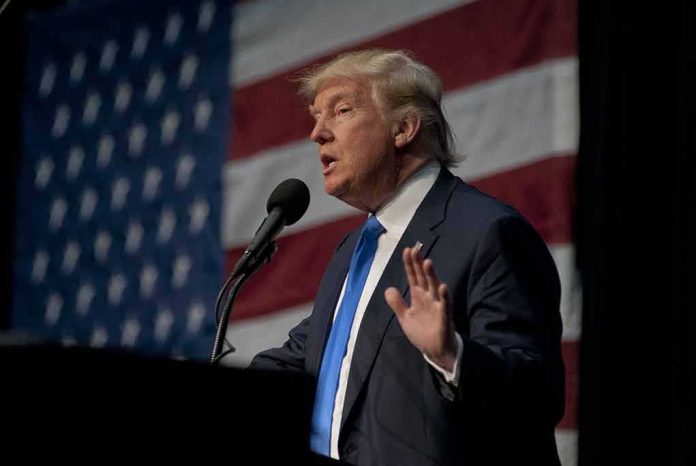
Trump’s furious attack on the Senate’s blue slip rule exposes a century-old tradition now weaponized to shape the very DNA of America’s federal courts, sparking urgent questions about who truly controls justice in the United States.
Story Snapshot
- The blue slip process lets home-state senators block federal judicial nominees, fueling partisan standoffs.
- Trump’s public condemnation has reignited demands to abolish or reform the tradition in 2025.
- Both parties have wielded blue slips to obstruct judicial picks, intensifying the battle over America’s courts.
- Advocacy groups argue the blue slip undermines diversity and fairness, while defenders say it protects state interests.
Trump’s Outburst and the Blue Slip’s Power
Donald Trump’s recent tirade against the Senate’s blue slip rule was more than the latest political theater; it was a pointed attack on a tradition that has shaped judicial appointments for over a century. Trump blamed blue slips for blocking his judicial nominees, particularly in states controlled by Democratic senators during his presidency. His remarks cast the rule as an outdated relic, designed for courtesy but now used as a partisan cudgel to stall the federal courts’ evolution. This outcry has reignited a fierce debate: Is the blue slip a vital check on presidential power, or is it a tool of obstruction that sabotages the justice system?
The blue slip’s power lies in its simplicity. A single senator can approve or veto nominees for federal courts in their state, giving individual lawmakers extraordinary leverage over national judicial appointments. Trump’s administration saw this first-hand, as Democratic senators slowed or stopped his picks—especially for district courts—by refusing to return blue slips. The Senate Judiciary Committee chair controls how strictly the rule is enforced, creating a dynamic where partisan control determines the fate of nominees. The process is not written into law but has become a battleground for influence, with both sides using it strategically depending on who holds the gavel.
Historical Roots and Partisan Evolution
Originating as an informal courtesy in the early 20th century, the blue slip tradition aimed to ensure home-state senators had input on judicial nominees. As judicial appointments grew more contentious, the blue slip morphed from a polite request into a potential veto, especially for district court seats. Over decades, its enforcement has varied by Judiciary Committee leadership and the prevailing party, sometimes honored as a sacred tradition, other times cast aside for political expediency. The Obama era saw blue slips block several nominees, and the Trump administration experienced similar roadblocks. Republicans later used the process to stymie Biden’s picks, highlighting a pattern of escalating tit-for-tat obstruction.
This partisan evolution has made the blue slip emblematic of broader dysfunction in the judicial appointment system. Advocacy groups such as Alliance for Justice argue that blue slips have become a barrier to diversity and fair representation in the courts, with vacancies lingering and communities waiting for justice. Critics say the process enables minority obstruction, distorting the courts’ ideological balance and undermining public trust. Defenders counter that the blue slip protects state interests and senatorial prerogatives, ensuring local concerns are considered in lifetime appointments.
Current Battle Lines and Reform Push
Trump’s renewed criticism in 2025 has galvanized reform advocates, who view the blue slip as ripe for abolition. Over 30 organizations, including Alliance for Justice, have called for its end, citing data showing partisan asymmetry—Republicans have returned fewer blue slips for Biden’s nominees than Democrats did for Trump’s. The result is an uneven playing field, with judicial vacancies disproportionately affecting states led by the opposing party. The Judiciary Committee chair’s discretion remains pivotal, as enforcement shifts with Senate leadership, fueling uncertainty about future nominations.
Trump Rages at ‘Stupid and Outdated’ Blue Slip Rule Thwarting His Judicial Picks https://t.co/SBMdWDu0Fn
— Boston Strong (@therealpuzzo) October 17, 2025
The immediate impact is felt in the courtroom, where delays and blockages slow the justice system. Litigants, lawyers, and affected communities endure longer waits, while the ideological makeup of the federal bench hangs in the balance. The long-term implications extend far beyond individual cases, influencing civil rights, business regulation, and social policy for decades. Legal scholars warn that persistent vacancies erode judicial diversity and politicize the courts, threatening the principle of impartial justice. As the debate intensifies, the question looms: Will the Senate finally break with tradition and overhaul the blue slip, or will it remain a flashpoint in the struggle for judicial control?
Sources:
Alliance for Justice, “To Transform Our Courts: End or Reform the Blue Slip”



